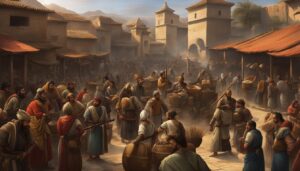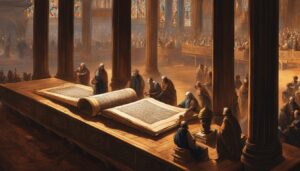
The study of symbols in Christian art is a fascinating exploration of the depth and meaning behind the visual representations found in biblical texts. George Ferguson’s book, first published in 1954 and still considered the authoritative source on the subject, delves into the symbolism inherent in representations of religious figures, the natural world, and objects in Christian art. It also explores how the Old Testament characters and events are symbolically portrayed in art. With over 350 illustrations and a comprehensive text, Ferguson’s work offers valuable insights into the rich symbolism of biblical art.
Key Takeaways:
- Art and symbolism in biblical texts provide a deeper understanding of the visual representations found in religious art.
- George Ferguson’s book is a comprehensive guide to the symbolism in Christian art, examining religious figures, the natural world, and objects.
- The use of symbolism in biblical art allows for the expression of deeper meanings and connections to Old Testament characters and events.
- Ferguson’s work contains over 350 illustrations, enhancing the reader’s understanding of the rich symbolism in biblical art.
- Exploring the symbolism in biblical art can deepen our understanding of the texts and their timeless relevance.
The Intersection of Art and the Bible in the Bible and the Arts Collection
The Bible and the Arts Collection offers a diverse and interdisciplinary exploration of the intersection between art and the Bible. This comprehensive compilation includes studies examining various art forms such as visual arts, music, literature, and popular culture, all with a focus on biblical art and symbolism. By delving into the rich visual language found in biblical texts, these works shed light on the deeper meanings and messages conveyed through artistic representations.
One area of focus within the Bible and the Arts Collection is the examination of biblical imagery in literature. Authors in this collection analyze how writers from different time periods have incorporated biblical symbolism into their works. This exploration showcases the lasting impact and timeless relevance of biblical themes in storytelling and literature.
The Bible and the Arts Collection provides valuable insights into the role of art and symbolism in biblical texts, offering a unique perspective on the rich visual language of the Bible and its influence on various art forms.
Visual art is also a prominent feature in the collection, with studies dedicated to Christian symbolism and the use of biblical narratives in artwork. These works delve into the ways in which artists throughout history have utilized symbolism to convey spiritual and metaphorical concepts present in biblical texts. By examining the visual representation of biblical stories and characters, these studies deepen our understanding of the intricate relationship between art and the Bible.
The Bible and the Arts Collection: A Table of Contents
| Book Title | Author | Art Form |
|---|---|---|
| The Symbolism of Christian Art | George Ferguson | Visual Arts |
| Biblical Imagery in Modern Literature | Sarah Thompson | Literature |
| Christian Allegory in Music | David Reynolds | Music |
| The Cinematic Bible: Scripture in Film | Michael Jenkins | Film |
The Bible and the Arts Collection offers a comprehensive exploration of biblical art and symbolism, showcasing the deep connections between the visual arts and the Bible. Through this interdisciplinary approach, readers can gain valuable insights into the intricate relationship between art and biblical texts, further enhancing their understanding of the rich symbolism present in religious art.
The Ethical Implications of Christian Art in The Art of Christian Reflection
When exploring the intersection of art and biblical texts, one cannot overlook the ethical implications that arise from Christian art. In her renowned book, The Art of Christian Reflection, Heidi J. Hornik delves into the deeper meaning and symbolism found in classical artwork while shedding light on how art can foster Christian virtues and engage with contemporary moral issues. Through her analysis of over eighty different pieces of art, including paintings, sculptures, and architecture, Hornik reveals the profound impact that art can have on shaping our behavior and challenging societal norms.
“Art at its best is a powerful tool that can awaken our senses, evoke empathy, and encourage us to consider the ethical implications of our actions.”
Hornik’s exploration of art and ethics extends beyond the portrayal of biblical narratives; it encompasses a wide range of topics, from racism and violence to poverty and environmentalism. By examining art through the lens of Christian reflection, she emphasizes the transformative power of visual mediums in inspiring viewers to embody Christian virtues such as forgiveness, patience, and generosity. Through the careful analysis of symbolism and meaning in classical artwork, The Art of Christian Reflection invites readers to engage with art as a form of discipleship and a means to connect with the ethical implications found within biblical texts.
As we delve deeper into the world of Christian art, we begin to unravel the intricate relationship between artistic expression and ethical considerations. Hornik’s work serves as a testament to the enduring relevance of biblical symbolism in visual art and its ability to provoke thoughtful reflection and inspire virtuous action. By embracing art as a medium for engagement and dialogue, we can forge a deeper connection with the messages and teachings of the Bible, contributing to a more compassionate and just society.
Biblical Symbolism in Visual Art
One fascinating aspect of Christian art is the incorporation of biblical symbolism, which adds layers of meaning to visual representations. The use of symbols in art dates back centuries and serves as a powerful tool for artists to communicate complex theological concepts and narratives. From the depiction of the cross, which symbolizes Christ’s sacrifice and redemption, to the dove, representing the Holy Spirit, biblical symbolism in visual art creates a visual language that enables viewers to connect with the spiritual realm. By understanding and interpreting these symbols, we can deepen our appreciation for the rich heritage of Christian art and its ability to convey profound messages.
| Symbol | Meaning |
|---|---|
| The Cross | Symbolizes Christ’s sacrifice, redemption, and the central message of Christianity. |
| The Dove | Represents the Holy Spirit and the peace and purity associated with it. |
| The Lamb | Symbolizes innocence, purity, and Christ as the sacrificial lamb. |
| The Fish | Ancient symbol of Christianity, derived from the Greek word “ichthys,” representing Jesus Christ. |
| The Crown of Thorns | Signifies Christ’s suffering and his ultimate triumph over death. |
These are just a few examples of how biblical symbolism enriches visual art, inviting contemplation and deeper exploration of the stories and teachings found in the Bible. The use of such symbols allows artists to create visually engaging and spiritually resonant artworks that connect viewers with the essence of Christian faith.

By delving into the ethical implications of Christian art and the symbolism found within biblical texts, we unlock a deeper understanding of the messages conveyed through visual representations. The art of Christian reflection prompts us to consider how art can inspire virtuous behavior and challenge societal norms, ultimately fostering a more compassionate and just society.
Conclusion
The exploration of art and symbolism in biblical texts unveils a captivating realm of imagery, stories, and profound meaning. From George Ferguson’s meticulous analysis of symbols in Christian art to the interdisciplinary approach of the Bible and the Arts Collection, it becomes evident that artists across history have harnessed the power of symbolism to convey deeper truths within biblical narratives.
By diving into the world of biblical art, we gain access to a visual journey that expands our understanding of these sacred texts. The comprehensive text and over 350 illustrations in Ferguson’s work provide valuable insights into the rich symbolism found in religious figures, the natural world, and objects depicted in Christian art.
Furthermore, the Bible and the Arts Collection offers a diverse compilation of studies that explore the intersection of art and the Bible. Through various art forms like visual arts, music, literature, and popular culture, this collection unravels the intricate connections between biblical imagery, Christian symbolism, and the use of Scripture in different creative expressions.
Finally, Heidi J. Hornik’s The Art of Christian Reflection delves into the ethical implications of classical artwork, demonstrating how art can inspire Christian virtues and address contemporary moral issues. By connecting art to behavior and beauty to Christian practices, Hornik reveals art as a powerful tool for discipleship and engaging with the ethical dimensions of biblical texts.
Through the exploration of art and symbolism, we deepen our understanding of biblical texts while also connecting with their timeless relevance. It is through the creative lens that we can unravel the hidden truths and messages within the sacred, paving the way for a richer, more profound comprehension of biblical narratives.
FAQ
What is the significance of studying symbols in Christian art?
Studying symbols in Christian art allows for a deeper exploration of the meaning and depth behind visual representations found in biblical texts.
What is George Ferguson’s book about?
George Ferguson’s book delves into the symbolism inherent in representations of religious figures, the natural world, and objects in Christian art. It also explores how the Old Testament characters and events are symbolically portrayed in art.
What is included in the Bible and the Arts Collection?
The Bible and the Arts Collection is a compilation of works that examine the intersection of art and the Bible. It includes studies on biblical imagery in literature, Christian symbolism in visual art, and the use of Scripture in book and film adaptations.
What does Heidi J. Hornik’s book explore?
Heidi J. Hornik’s book, The Art of Christian Reflection, examines the relationship between art and ethics in classical artwork. It analyzes various pieces of art to reveal how it can foster Christian virtues and address moral issues.
Why is art and symbolism important in biblical texts?
Art and symbolism in biblical texts offer a visual journey that deepens our understanding of the narratives, their rich imagery, stories, and messages.








